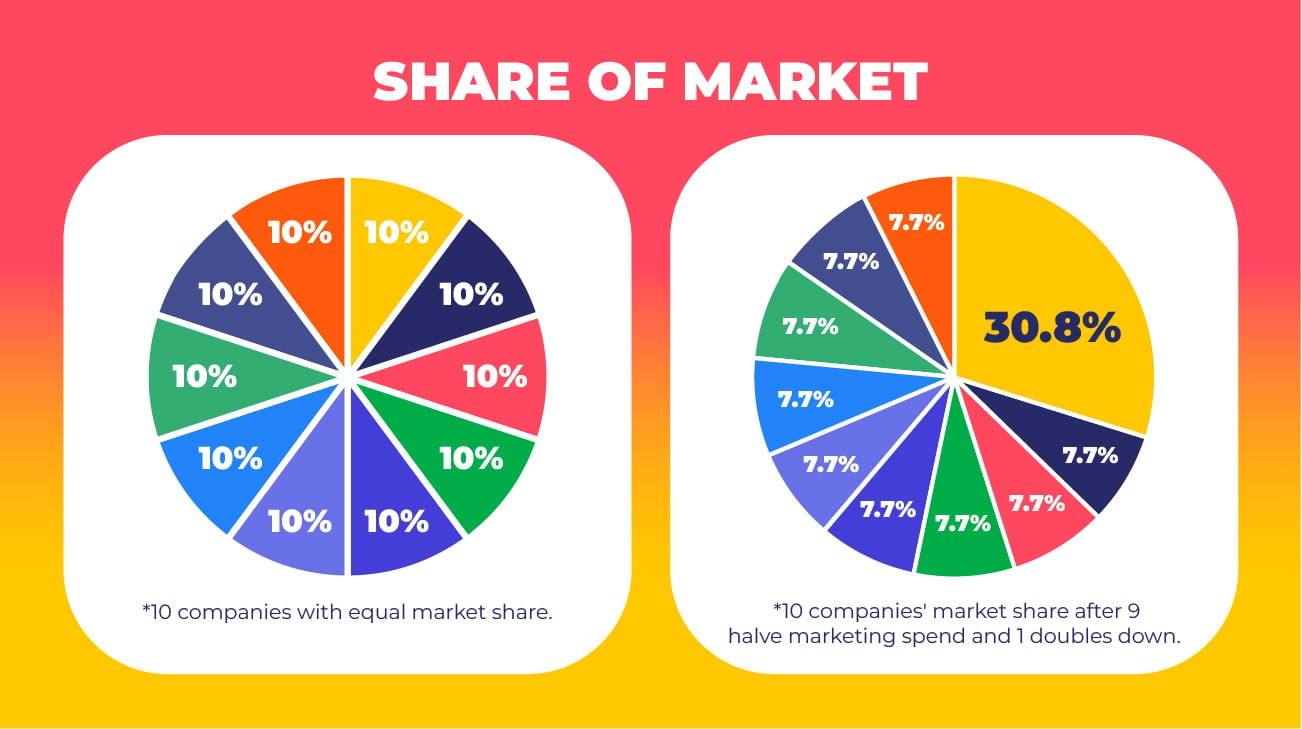Recession? Maybe. With all of this uncertainty, the best thing to do now is hope for the best and prepare for the worst. This article will outline the perfect recipe to better manage your budget so that you can reduce spend in the areas that aren’t working and reallocate your budget to the areas that are.
Don’t cut marketing budget

Step 1: When dieting, you might feel the urge to cut out the fats, but some fats are necessary for a healthy glow.
In times of economic downturn, marketing budgets are usually the first to be slashed and the last to be reinstated. But please don’t do this if you want to get ahead of the game, because marketing is a necessary fat.
History shows that companies (Procter & Gamble, anybody?) who have spent more on marketing during economic difficulties have reaped better results than their counterparts.
The reason is simple. During a recession, the companies that reduce marketing budget open up more space for their competitors to improve their share of voice (SOV) and share of market (SOM).
For example, if there are 10 companies with an equal share of market, and 9 cut their budget in half while 1 doubles down, the company that doubles marketing spend improves their percentage of market share from 10% to 30.8%. Meanwhile, the other 9 companies that cut budget by half decrease their overall share of market from 10% down to 7.7%.

So think twice before prioritising the illusion of short-term savings (fast fad diets) over long-term value (a healthy, well-rounded diet).
Lesson: In times of good or bad, marketing is necessary for a healthy glow.
Don’t swap long-term strategy for short-term success
Step 2: Swapping out one ingredient for another seemingly healthier one isn’t necessarily better.
As marketers aim to be more efficient to prove their value to CFOs, a growing emphasis on performance marketing has emerged. And while performance marketing is important, be sure not to trade out long-term investments in branding for short-term performance marketing success.
In reality, you should maintain investments in both, because over-emphasising sales and neglecting brand-building opportunities to achieve fast results is a losing game that will damage your reputation and your future budget down the line.
Know the industry’s appetite
Step 3: Be aware of which way the trends are heading and where other brands are putting their money.
For one, there has been a rising shift from Search to Display ads, with the Association of National Advertisers predicting that Display ads will outdo Search ads in 2023. Recipe Hint: Reallocate some money and effort toward Display ads, if you aren’t already.
It’s also important to know what type of media other marketers plan to invest in. Kantar found that online video ads, branded content by influencers, and ads in social media feeds are the top three areas advertisers seek to increase their budget spend in 2022.
Image source: Kantar
Another extraordinarily important trend to keep an eye on is CPM and CPC, because with a recession looming, both have begun to fall. A recent study done by Dreamdata found that 54% of the sampled B2Bs have stopped putting money into Facebook, 42% halted spend on Linkedin ads, and 16% stopped spending on Google ads since July 2021. These budget cuts bring back my previous point that a recession is a prime time to build market share.
Image source: Dreamdata
Eliminate wasted spend
Step 4: Now is not the time to be wasteful, so make sure you’re making the most out of your ingredients for a healthier budget.
You can do this by using product performance data to focus your budget on the right products. This can be a bit tricky to achieve though as most retailers and marketers don’t actually have access to or understanding of their own product performance data.
So if you are a marketer or retailer and don’t know the value of product performance data, let me assure you, you’re missing out.
Product performance data is unique in that it shows the performance of each individual product through metrics like margin, revenue, and number of transactions, so you can determine and exclude your low-performing products and low-or-no stock items from promotion and much more.

Not only does product performance data allow you to better choose which products are worth promoting, but it also helps your purchasing team decide which products you should and shouldn’t spend money on.
Learn more about how to use your product performance data here.
Be ready for change
Sometimes, the final product of a recipe doesn’t come out quite as expected. External forces, ingredient mishaps, and food quality can all change a final form.Our advice: Be prepared to adapt or die (dramatic for a recipe, I know). But the past few years have shown that this sentiment rings true for handling a business in times of turmoil, and unfortunately, we’ve found ourselves in the thick of it again.
So to better your budget this next year, clearly define one with bigger long-term goals in mind, making sure that your budget leaves room for the unpredictable, boosts spend where it’s working, and reduces and reallocates budget from where it’s not.
In uncertain times, being prepared to adapt for the worst is never a bad idea, so long as you do it right.


.png)
